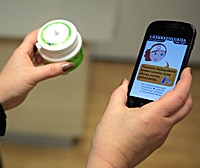The Finnish R&D company’s HearMeFeelMe project focused on how NFC could be used to improve the way elderly and visually impaired people interact with the world around them, including a system that allows product information to be recorded on an NFC tag and then read back to the user via an NFC phone.

VTT Technical Research Centre of Finland has unveiled details of an NFC research project designed to make life easier for the elderly and visually or audibly impaired people.
VTT worked with Finland’s Top Tunniste, Tecnalia of Spain and Demokritos from Greece on the HearMeFeelMe project, which focused on the use of NFC in the medical arena but could equally be applied to food labelling and other fields. Applications developed included:
- Talking medicine packaging. When read by an NFC phone, spoken dosage instructions and other important information can be delivered to the user. The data was stored on the NFC chip by pharmacy staff and could be listened to by the user at home.
- Touch ‘n’ tag. A mobile phone application that enables visually impaired users to identify everyday items, including food, with the help of voice memos. To record a memo tag, the user touches the NFC label on the packaging and dictates the information into the phone. The recording can then be listened to by touching the label again with the phone. During testing, this was found to be the users’ favourite app and was most commonly used to mark food packaging. Benefits were seen from recognising items and recalling product information as well as from the ability to record the desired information in the user’s own words.
- Medication almanac. This application is designed to ensure medications are taken at the right time by automatically notifying the patient’s chosen family members or medical staff when medication is due. Nurses and family members can then send a reminder to the patient’s mobile phone. The patient then replies with an acknowledgement via NFC by, for instance, touching the pill container with their NFC phone.
Transforming written information into speech is easy in technical terms and would be of great benefit to old people and visually impaired persons of all ages, says VTT. In the future, “visually impaired people may use NFC applications for a variety of purposes, including item recognition, spoken product information on food or medicine packaging, personal reminders, calendars or spoken manuals for home appliances.”
Next: Visit the NFCW Expo to find new suppliers and solutions